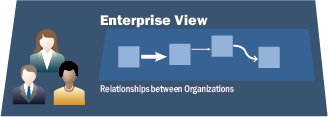Enterprise Objects

Stakeholders take roles in the consumption and delivery of ITS services. When a stakeholder participates in ITS, that stakeholder takes a role—modeled in ARC-IT as an Enterprise Object—and thus acquires implied relationships and responsibilities within the context of the services in which they participate. ARC-IT defines these roles, but since ARC-IT is a reference architecture, only realized architectures can map stakeholders to Enterprise Objects. Consequently, regional architectures developed in RAD-IT include the facilities to identify stakeholders, associate stakeholders with roles and responsibilities, and determine the relationships those stakeholders should have to deliver ITS services.
Enterprise Objects are used to help frame discussions such as "who is responsible for what?" and "how does each user interact with ITS?" Enterprise Objects are defined based on their role with respect to ITS. For each physical object and role combination, there is precisely one enterprise object. So for example, for the Traffic Management Center, ARC-IT defines:
- Traffic Management Center Developer
- Traffic Management Center Installer
- Traffic Management Center Maintainer
- Traffic Management Center Manager
- Traffic Management Center Owner
- Traffic Management Center Supplier
- Traffic Management Center Verifier
- Traffic Operations Personnel (Operator)
Within RAD-IT and SET-IT stakeholders are mapped to Enterprise Objects just like ITS systems and equipment are mapped to physical objects in Physical View. These Enterprise mappings are based on the roles each stakeholder performs.